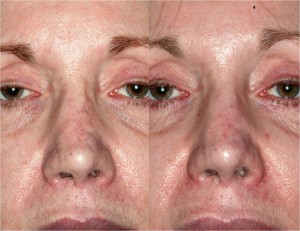Nose Fat Grafting Using Coleman Technique Provides a Natural Solution
Posted October 29, 2008 in Facial Reconstruction
Nose fat grafting provides surgeons with new tools to compliment their nasal surgery. Fat grafted to the nose by the Coleman method is surprisingly well integrated, assuming the structural a quality of the part of the nose into which it is placed.
Shape
Rhinoplasty surgeries often leave a nose with an “open roof.” The cartilage and bony parts of the nose have been separated so that it looks like a long trough through which the septum can be felt or even seen through the thin skin on the nose in this condition. In addition, the cartilage or bone can become deformed in many ways after rhinoplasties. The skin of the nose in some patients is so thin that irregularities can be amazingly visible, so that many structures are painfully visible through the skin after nasal surgery.
This woman had four nose procedures on both coasts and silicone injections to the nose. Follow-up at one year from one procedure (right) reveals a remarkably more normal appearing nose. The upper nose flows more naturally into the lower nose, with a more distinct central light reflex and many less irregularities. Placement into the nostril rim flattened the notching and appears to have pushed the nasal tip over to the middle from the right.
Coverage
Placing a thin layer of fat under the skin provides support for the skin and can disguise visible irregularities of the cartilage and bone. Concentrating the fat grafts into specific areas can improve the light reflex down the middle of the nose or subtly change the proportion of one part of the nose to another part.
This patient presented after at least 12 previous nasal procedures, including GorTex placement and removal, numerous cartilage grafts from her ears and one from her chest. The markings demonstrate the areas of placement. One year after one procedure, you can see softening of the irregular cartilages along with an apparent thickening of the skin over the entire nose. The area between the eyebrows is slightly fuller with a lessening of the frown wrinkles.
For more information, go to the nose section of our LipoStructure.com website.
© Coleman 2008 and 2012

